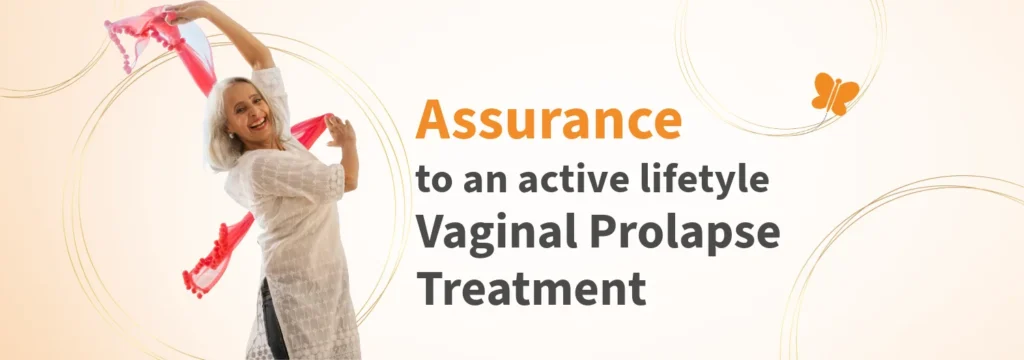

Breaking the Silence
Everything you need to know about Urine Incontinence in Women
Urine incontinence is a health issue that disproportionately impacts women, affecting their daily lives and overall well-being. Despite its prevalence, it remains a topic shrouded in embarrassment and misunderstanding.
What is Urine Incontinence ?
Urine Incontinence is when urine involuntarily releases, as an unexpected leak or a strong sudden urge to pee that is impossible to control. For most women, this can range from a minor annoyance to a significant distressing concern. This condition can significantly impact a woman’s daily life, causing discomfort, embarrassment, and anxiety.
IWe should remember that Urine Incontinence is a symptom of underlying medical conditions, and not a disease in itself. It is helping you to identify the weakness of specific muscles that need to be medically checked and treated.
What are the Types of Urinary Incontinence ?
- Stress Incontinence: This occurs when physical movement or activity puts pressure on the bladder, causing urine leakage. Common triggers include coughing, sneezing, laughing, or exercising.
- Urge Incontinence: Also known as overactive bladder, this type is characterized by a sudden, intense urge to urinate followed by an involuntary loss of urine. Women with this condition may need to urinate frequently, including throughout the night.
- Mixed Incontinence: This is a combination of stress and urge incontinence.
- Overflow Incontinence: This occurs when the bladder doesn’t empty completely, leading to frequent or constant dribbling of urine.
- Functional Incontinence: This type is caused by physical or mental impairments that interfere with a person’s ability to reach the toilet in time.
What causes Urine Incontinence in Women : Unveiling the Mystery
Unearthing the root cause is key in discovering the best treatment plan for each individual. It’s important to remember that while this condition is more common in older women, it can affect females of all ages.
- Pregnancy and Childbirth: The weight of the growing baby in the uterus during pregnancy and the physical strain of a vaginal (normal) delivery can weaken the pelvic floor muscles of the woman, damage the bladder nerves and supportive tissues, leading to incontinence.
- Menopause: The decrease in estrogen levels may lead to a weakening of the urethra, which is critical in maintaining urinary continence.
- Hysterectomy: This surgical procedure of uterus removal can damage pelvic floor muscles and the supporting ligaments.
- Urinary Tract Infections (UTIs): These can irritate the bladder, causing strong urges to urinate and potential leakage.
- Neurological Disorders: Conditions such as multiple sclerosis, Parkinson’s disease, and stroke can interfere with nerve signals involved in bladder control.
- Obesity: Excess weight may put additional pressure on the bladder and surrounding muscles, leading to incontinence over time.
What are the symptoms of Urinary Incontinence ?
Urine Incontinence is primarily defined by involuntary (not under your conscious control) leaking of urine. However, depending on the type and severity, women may experience:
- Leaking urine when coughing, sneezing, exercising, jumping
- Sudden, intense urges to urinate
- Frequent urination, including waking up multiple times at night to urinate
- Constant dribbling of urine
- Incomplete emptying of the bladder
What is the impact of Urine Incontinence on Women ?
Urine incontinence does more than just disrupt a woman’s daily routine.
Emotional Distress : It affects their emotional health, relationships, quality of life, productivity at work, and overall wellness.
Social Isolation : It can lead to feelings of embarrassment, worsened mental health issues, and reduced physical activity due to fear of leakage.
Physical Discomfort : Urine incontinence also increases the risk of recurrent urinary tract infections. It may range in severity in women. The problem may also exacerbate over time
Impact on Sexual Health: Fear of leakage may lead to anxiety and avoidance of intimacy
Professional Impact: Work performance may be affected due to frequent bathroom breaks or discomfort, especially in women following travel intensive careers.
Sleep Disturbances: Frequent nighttime urination can disrupt sleep patterns
Recognizing the gravity of this health issue, it’s crucial to openly discuss it to break the associated stigma. Timely correction of the problem also helps alleviate the potential financial costs involved in treatments of severe urinary incontinence.
How can a doctor diagnose Stress Urine Incontinence ?
The diagnosis of Stress Urinary Incontinence can be done with the help of a thorough physical examination, medical history evaluation, and a discussion of symptoms.
The doctor will also rule out other conditions that may cause similar symptoms for eg infections, blood loss in urine or any other abnormilities. The doctor may also order a simple neurological test to undertand any potential pelvic nerve issues. If you are observing the symptoms of Stress Urinary Incontinence, it is suggested that you maintain a urinary diary to keep a record of urination on the everyday basis.
Stress Urinary Incontinence is treatable. There are numerous options available to women to overcome this condition at early onset.
I) Lifestyle Changes Making certain lifestyle adjustments can help manage and reduce symptoms of urine incontinence:
- Fluid Management: Drinking the right amount of fluids and avoiding excessive intake of caffeine and alcohol can help control symptoms.
- Weight Management: Losing excess weight can reduce pressure on the bladder and pelvic floor muscles.
- Bladder Training: Scheduled voiding and bladder training exercises can help improve bladder control.
II) Pelvic Floor Exercises : Often Kegel exercises are effective for strengthening the pelvic floor muscles. These muscles support the Urinary bladder and hence, help control the process of urination. With kegel excercises, a patient needs to contract and relax their pelvic muscles consistently, to strengthen them. This strengthening helps the muscles to control urine flow and minimize involuntary leakage. Regular practice can significantly reduce symptoms of stress incontinence.
III) Medications : A special medication is given by the doctors to SUI patients to relax the bladder muscle so that it can increase its capacity to hold more amount of urine. However, mere medications have not been clinically significantly helped reduce symptoms and hence, is not usually a preferred treatment for Stress Urinary Incontinence.
IV) Medical Devices : Medical devices can be used to manage urine incontinence. Many women are comfortable using medical devices over long period of time to relieving symptoms of urinary incontinence. On the other hand, many women opt for simpler treatments to get rid of this condition once for all.
- Urethral Inserts: These are disposable devices inserted into the urethra before an activity like exercising to prevent leaks.
- Pessary: A pessary is a stiff ring inserted into the vagina to help hold up the bladder and prevent leakage.
V) Non Invasive Treatments

We have all heard about the age old Kegel excercises. However, in order to get a significant result from kegel excersises, it is imperative to consistently do kegels over long period of time.
Today, effective treatments are available at Elle Sante which deliver 100% non invasive kegel like contractions to the pelvic area of the patient while sitting on a state of the art Electromagnetic Pulsating Chair.
- The patient is fully clothed during the procedure
- The treatment takes 30-45 minutes only
- The results have been clinically proven as the patient recieved 1000s of kegels within each session.
- The number of sessions will be recommended by a skilled reconstructive & cosmetic gynaecologist
- The patient can feel results from the very first session.
- There is no downtime. This means the patient returns to their normal lifestyle almost immediately after the session.
VI Minimal Invasive Treatments
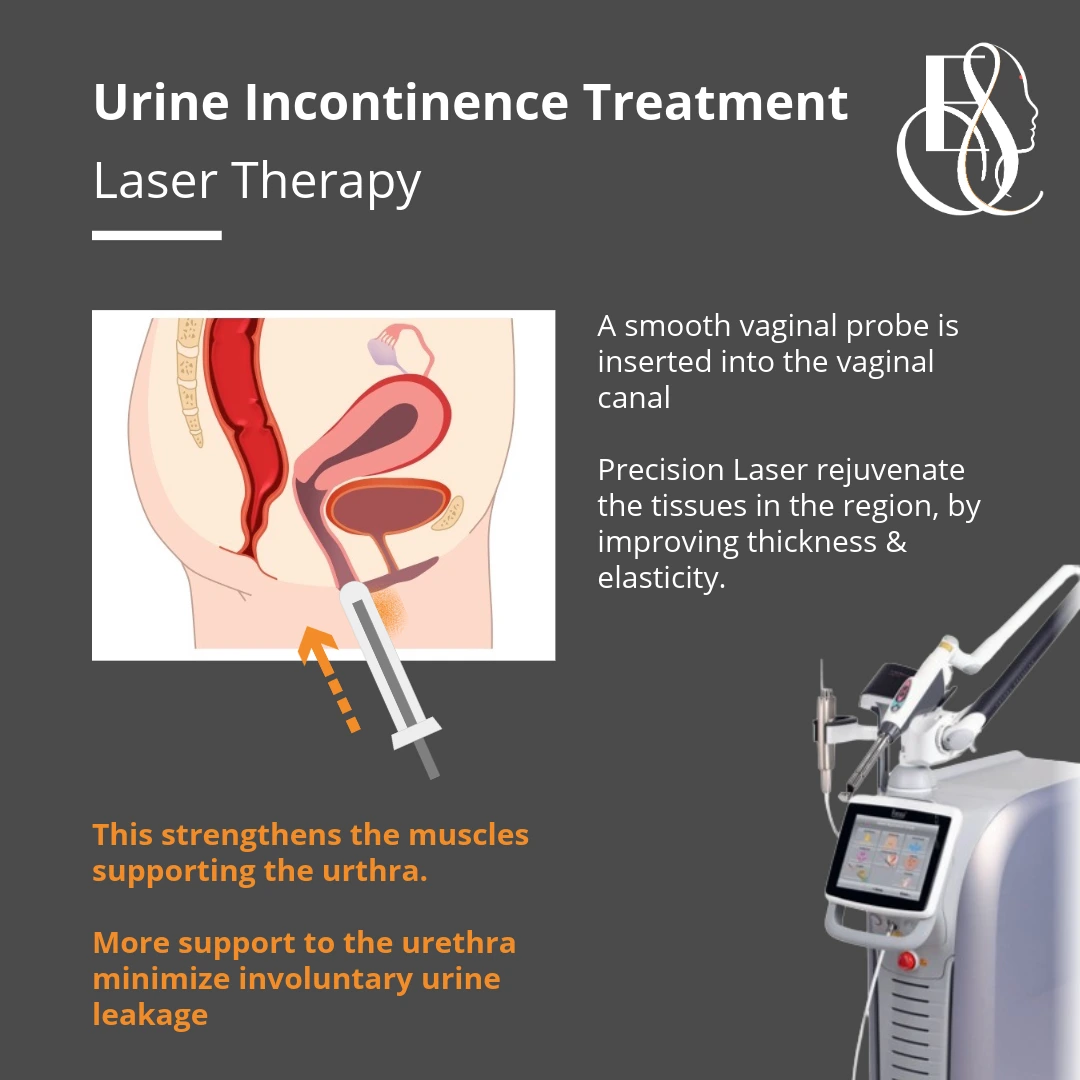
As the name suggests, Minimal invasive treatment options for Urinary Incontinence means a probe is used to delivery waves from within.
This probe may use Laser Technology, which is a rampantly used and proven technology, or Radiofrequency Technology.
Both methods heal the vaginal region through the vaginal canal, by effectively producing soft heat waves to rejuvenate the tissues and encourage collagen production.
- There is very low downtime and this is an outpatient procedure
- The patient is fully draped during the treatment
- The number of sessions are recommended by a skilled reconstructive & cosmetic gynaecologist depending on the severity of the condition
- The patient is fully awake during the procedure and feels minimal discomfort of the probe entry
- A complete session lasts appro. 1 hour which includes treatment and consultation time
VII Surgical Options
While we prefer to offer minimal invasive and non surgical options for Urine Incontinence, many women may need a surgical intervention due to the severity of their condition. Women should not “experiment” on such surgical procedures as they include a high level of complexity. You should only trust a skilled reconstructive & cosmetic gynaecologist who has very high level of expertise in persforming surgical treatments specific to women pelvic area.
For such severe cases of urine incontinence, surgical interventions may be necessary:
- Slings: A sling procedure involves creating a hammock of synthetic mesh or your tissue to support the urethra and help keep it closed. This sling is then surgically suspended inside the body and gently lifted to provide the necessary strength to withstand simple stress. The urethra hence, does not leak involuntarily.
The procedure is fairly complicated, and must be done with utmost precision. A skilled surgeon should be consulted for sling procedure. There are small incisions made in the pelvic area to suspend the sling and stretched.
- Bladder Neck Suspension: This surgery provides support to the urethra and bladder neck. The procedure is a surgical treatment which works on the principle of suspending the neck of the urethra from the pelvic tissue around it.
Surgical Interventions, as any surgery, require fair precaution and have risk involvement. A trained reconstructive & cosmetic gynaecologist will be able to alleviate urine incontinence problems at an advanced healthcare facility.
- The procedure a small recovery period
- The procedure involves anaesthesia so the patient will be required to stay on the premise for a few hours post the surgery, or depending upon the recommendations of the surgeon
- The results of sling surgery are fairly permanent and women feel the change post healing
Frequently Asked Questions
Is Urine Incontinence a normal part of aging
Can I prevent urinary incontinence?
Will Kegel exercises cure my incontinence?
Can normal (vaginal) childbirth cause permanent incontinence?
What is the most common type of urine incontinence in women?
Can urine incontinence be cured?
How do I know if I need treatment for urine incontinence?
Is it normal to leak urine during exercise?
Who treats Urine Incontinence ? I thought a urologist handles these type of cases.
Approximately 1 in every 3 women Globally suffer from Urine Incontinence. It varies in severity from woman to woman and it may only worsen with time. This is a treatable condition, and there are multiple options available at Elle Sante – non surgical, minimal invasive to surgical treatments.
Dont just Learn to Live with it !
Consult the most skilled and trustworthy Reconstructive & Cosmetic Gynaecologist, Dr Navneet Magon. He has over 30 years of experience and has done over 25000 procedures in the field. Dr Navneet Magon is an adept surgeon who has also honed his professional craft in providing non invasive and minimal invasive treatment options to his patients.
Why Chose Elle Sante Clinics
Elle Sante Chain of Clinics for Reconstructive & Cosmetic Gynaecology are conveniently located in Gurgaon, Hyderabad, Mumbai, 10 + more locations in India and are constantly growing. Elle Sante Clinics are the only clinics dedicated to Women’s Pelvic Area Concerns, offering the most advanced technologies in Non Surgical, Minimal Invasive and Surgical Treatments.
Only Clinic in India
to offer extentive range of treatment options
Extensively Skilled
& Globally Trained Team of Doctors
Globally No 1
in Innovative & Benchmark Treatments
State of the Art
Clinics & Global Standards of Patient Centered Care
Discuss your queries on Urine Incontinence
-
+91-8811 009 900+91-8811 009 900
-
WhatsApp Us (24/7)WhatsApp Us (24/7)
Mon-Sat 10:30am to 7:30pm
Sunday Closed
-
info@ellesante.ininfo@ellesante.in
We respond within 24 hours
Contact Us
Elle Sante Range of Treatments
Elle Sante Clinics

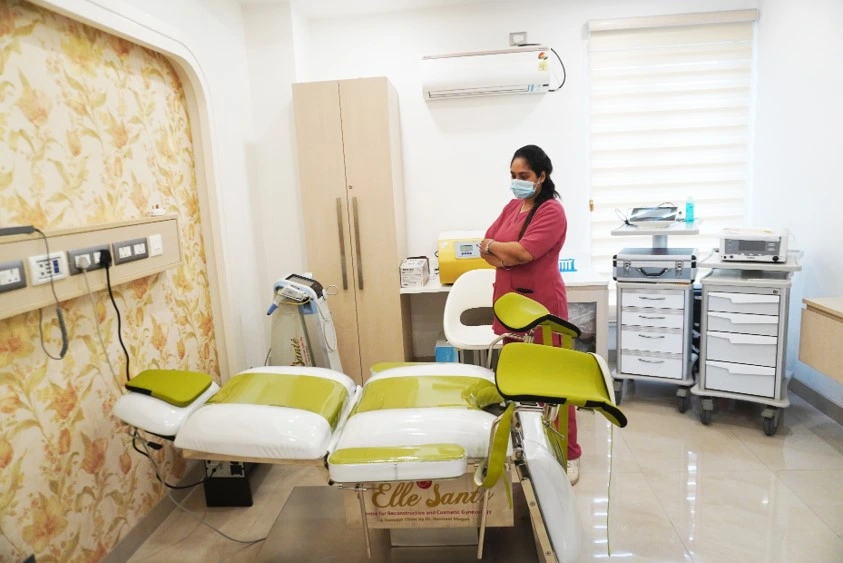
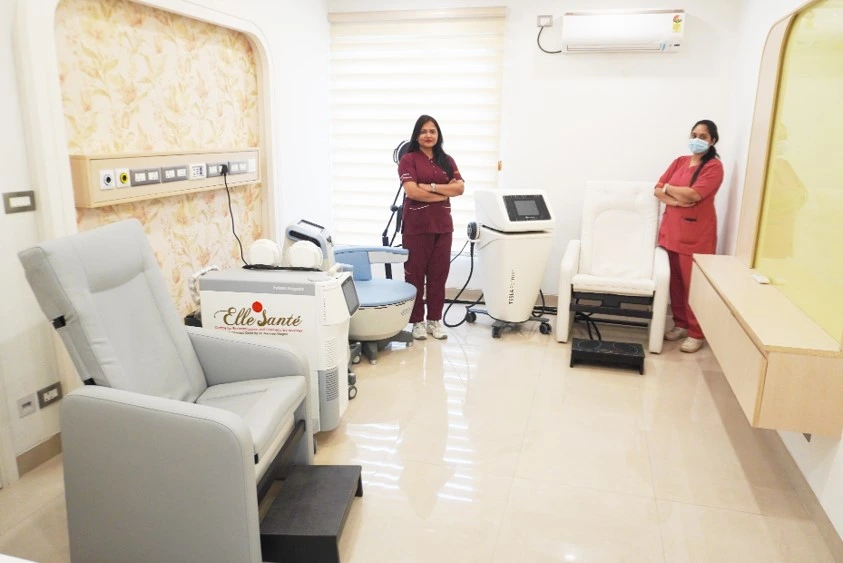
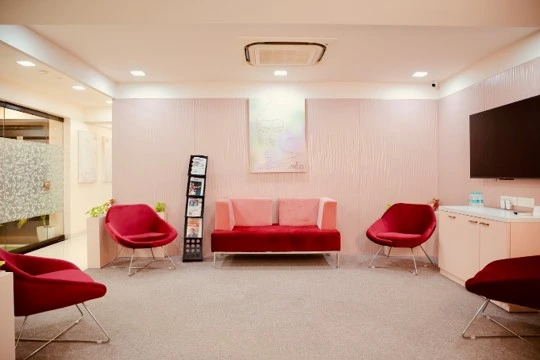


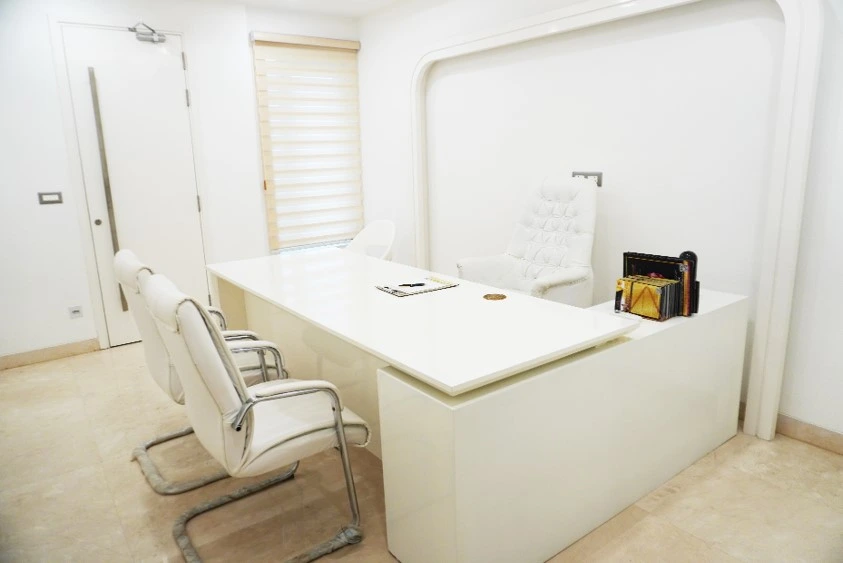
Elle Sante Gurgaon
NR – 38, Main, Nathupur Rd, DLF Phase 3, Sector 24, Gurugram, Haryana 122002
Elle Sante Mumbai
6th floor, S.M House, 11, Sahakar Rd, Vishnu Prasad Society, Navpada, Vile Parle East, Vile Parle, Mumbai, Maharashtra 400057
Elle Sante Hyderabad
C/o FMS Sculpt & Dental Hospital Door No. 8-2-293/82/A/725, Road No. 37, Hitech City Rd, nr Daspalla Hyderabad, CBI Colony, Jubilee Hills, Hyderabad, Telangana 500033
Elle Sante Visakhapatnam
Health city, Medcy Hospitals, Plot 9A, chinagadili, Arilova, Visakhapatnam, Andhra Pradesh 530040
Elle Sante Agra Pratappura Centre
Khandelwal Nursing Home, 3/27, Mahatma Gandhi Rd, khandelwal Colony, Pratap Pura, Rakabganj, Agra, Uttar Pradesh 282001
Elle Sante Rohtak
Elle Sante Nursing Home, C/o, Civil Rd, opposite Piller No. 22, HUDA Complex, Rohtak, Haryana 124001
Elle Sante Firozabad
Om Hospital and Research Centre, SN Rd, opposite PK Tiles, Devnagar, Nai Basti, Firozabad, Uttar Pradesh 283203
Elle Sante Agra
3rd Floor, Shanti Madhuban Plaza, 1/2, Delhi Gate Rd, Hariparwat, Professors Colony, Civil Lines, Agra, Uttar Pradesh 282002




